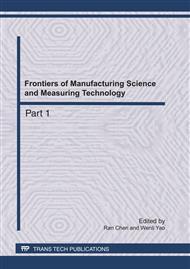p.293
p.298
p.301
p.306
p.310
p.315
p.320
p.324
p.329
A Macro-Micro Coupled Simulation of Positive and Negative Extrusion for Cardan
Abstract:
The cardan belong to dial the fork kind parts, its forming is difficult and forming high quality requirements. Establish macro-micro coupling, and a simulation model for the cardan negative extrusion forming process, a numerical simulation considering the deformation and heat conduction, deformation heat production, friction heat production, dynamic recrystallization and so on many factors. Analyze the deformation process detection cardan anti extruded deformation in advance and is extruded deformation. Meanwhile analysis showed that the cardan forgings have internal 59.929% area completely modification, have 4.7944% area did not happen dynamic recrystallization and didn't get forging modification, and forecasts the cardan internal grain size and distribution, the micro analysis for the prediction of forgings performance and design heat treatment process, provides the basis.
Info:
Periodical:
Pages:
310-314
Citation:
Online since:
May 2011
Authors:
Price:
Сopyright:
© 2011 Trans Tech Publications Ltd. All Rights Reserved
Share:
Citation:


